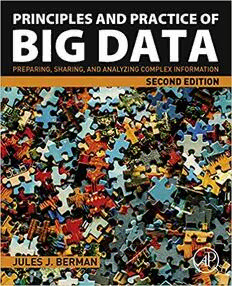Table Of ContentPrinciples and Practice
of Big Data
Principles and Practice
of Big Data
Preparing, Sharing, and Analyzing
Complex Information
Second Edition
Jules J. Berman
AcademicPressisanimprintofElsevier
125LondonWall,LondonEC2Y5AS,UnitedKingdom
525BStreet,Suite1650,SanDiego,CA92101,UnitedStates
50HampshireStreet,5thFloor,Cambridge,MA02139,UnitedStates
TheBoulevard,LangfordLane,Kidlington,OxfordOX51GB,UnitedKingdom
©2018ElsevierInc.Allrightsreserved.
Nopartofthispublicationmaybereproducedortransmittedinanyformorbyanymeans,
electronicormechanical,includingphotocopying,recording,oranyinformationstorageand
retrievalsystem,withoutpermissioninwritingfromthepublisher.Detailsonhowtoseekpermission,
furtherinformationaboutthePublisher’spermissionspoliciesandourarrangementswith
organizationssuchastheCopyrightClearanceCenterandtheCopyrightLicensingAgency,canbe
foundatourwebsite:www.elsevier.com/permissions.
Thisbookandtheindividualcontributionscontainedinitareprotectedundercopyrightbythe
Publisher(otherthanasmaybenotedherein).
Notices
Knowledgeandbestpracticeinthisfieldareconstantlychanging.Asnewresearchandexperience
broadenourunderstanding,changesinresearchmethods,professionalpractices,ormedical
treatmentmaybecomenecessary.
Practitionersandresearchersmustalwaysrelyontheirownexperienceandknowledgein
evaluatingandusinganyinformation,methods,compounds,orexperimentsdescribedherein.
Inusingsuchinformationormethodstheyshouldbemindfuloftheirownsafetyandthesafetyof
others,includingpartiesforwhomtheyhaveaprofessionalresponsibility.
Tothefullestextentofthelaw,neitherthePublishernortheauthors,contributors,oreditors,assume
anyliabilityforanyinjuryand/ordamagetopersonsorpropertyasamatterofproductsliability,
negligenceorotherwise,orfromanyuseoroperationofanymethods,products,instructions,orideas
containedinthematerialherein.
LibraryofCongressCataloging-in-PublicationData
AcatalogrecordforthisbookisavailablefromtheLibraryofCongress
BritishLibraryCataloguing-in-PublicationData
AcataloguerecordforthisbookisavailablefromtheBritishLibrary
ISBN:978-0-12-815609-4
ForinformationonallAcademicPresspublications
visitourwebsiteathttps://www.elsevier.com/books-and-journals
Publisher:MaraConner
AcquisitionEditor:MaraConner
EditorialProjectManager:MarianaL.Kuhl
ProductionProjectManager:PunithavathyGovindaradjane
CoverDesigner:MatthewLimbert
TypesetbySPiGlobal,India
Other Books by Jules J. Berman
Rare Diseases and Orphan Drugs
Taxonomic Guide to Infec(cid:415)ous Diseases Principles of Big Data
Keys to Understanding and Trea(cid:415)ng
Understanding the Biologic Classes of Preparing, Sharing, and Analyzing
the Common Diseases (2014)
Pathogenic Organisms (2012) Complex Informa(cid:415)on (2013)
9780124199880
9780124158955 9780124045767
Repurposing Legacy Data Data Simplifica(cid:415)on Precision Medicine and The Reinven(cid:415)on of
Innova(cid:415)ve Case Studies (2015) Taming Informa(cid:415)on with Open Human Disease (2018)
9780128028827 Source Tools(2016) 9780128143933
9780128037812
Dedication
Tomywife,Irene,whoreadseveryday,andwhounderstandswhybooksareimportant.
About the Author
Jules J. Berman received two baccalaureate degrees
fromMIT;inMathematics,andinEarthandPlanetary
Sciences.HeholdsaPhDfromTempleUniversity,and
anMD,fromtheUniversityofMiami.Hewasagraduate
studentresearcherintheFelsCancerResearchInstitute,
atTempleUniversity,andattheAmericanHealthFoun-
dation in Valhalla, New York. His postdoctoral studies
werecompletedattheUSNationalInstitutesofHealth,
and his residency was completed at the George
Washington University Medical Center in Washington,
DC.Dr.BermanservedasChiefofAnatomicPathology,
Surgical Pathology, and Cytopathology at the Veterans
AdministrationMedicalCenterinBaltimore,Maryland,
whereheheldjointappointmentsattheUniversityofMarylandMedicalCenterandatthe
JohnsHopkinsMedicalInstitutions.In1998,hetransferredtotheUSNationalInstitutesof
Health,asaMedicalOfficer,andastheProgramDirectorforPathologyInformaticsinthe
CancerDiagnosisProgramattheNationalCancerInstitute.Dr.Bermanisapastpresident
of the Association for Pathology Informatics, and the 2011 recipient of the Association’s
Lifetime Achievement Award. He has first-authored over 100 scientific publications and
has written more than a dozen books in the areas of data science and disease biology.
Severalofhismostrecenttitles,publishedbyElsevier,include:
Taxonomic Guideto Infectious Diseases: Understanding the Biologic Classes of
Pathogenic Organisms (2012)
PrinciplesofBigData:Preparing,Sharing,andAnalyzingComplexInformation(2013)
RareDiseases and OrphanDrugs: Keys to Understanding and Treatingthe Common
Diseases (2014)
Repurposing Legacy Data:Innovative CaseStudies (2015)
Data Simplification: TamingInformation with Open SourceTools (2016)
Precision Medicine and the Reinvention ofHuman Disease (2018)
xix
Author’s Preface to Second Edition
Everything has been said before, but since nobody listens we haveto keep
going back and beginningall overagain.
AndreGide
Goodsciencewriterswillalwaysjumpatthechancetowriteasecondeditionofanearlier
work.Nomatterhowhardtheytry,thatfirsteditionwillcontaininaccuraciesandmislead-
ingremarks.Sentencesthatseemedbrilliantwhenfirstconceivedwill,withthepassageof
time,transformintoexamplesofintellectualoverreaching.Pointstootrivialtoincludein
theoriginalmanuscriptmaynowseemlikeprofunditiesthatdemandafullexplanation.
Asecond edition provides rueful authors with anopportunityto correctthe record.
WhenthefirsteditionofPrinciplesofBigDatawaspublishedin2013thefieldwasvery
youngandtherewerefewscientistswhoknewwhattodowithBigData.Thedatathatkept
pouring in was stored, like wheat in silos, throughout the planet. It was obvious to data
managersthatnoneofthatstoreddatawouldhaveanyscientificvalueunlessitwasprop-
erly annotated with metadata, identifiers, timestamps, and a set of basic descriptors.
Undertheseconditions,thefirsteditionofthePrinciplesofBigDatastressedtheproper
andnecessarymethodsforcollecting,annotating,organizing,andcuratingBigData.The
processofpreparingBigDatacomeswithitsownuniquesetofchallenges,andtheFirst
Edition waspepperedwith warnings and exhortationsintended to steer readers clear of
disaster.
Itisnowfiveyearssincethefirsteditionwaspublishedandtherehavesincebeenhun-
dredsofbookswrittenonthesubjectofBigData.Asascientist,itisdisappointingtome
thatthebulkofBigData,today,isfocusedonissuesofmarketingandpredictiveanalytics
(e.g.,“Whoislikelytobuyproductx,giventhattheyboughtproductytwoweeksprevi-
ously?”);andmachinelearning(e.g.,driverlesscars,computervision,speechrecognition).
Machinelearningreliesheavilyonhypeduptechniquessuchasneuralnetworksanddeep
learning; neither of which are leading to fundamental laws and principles that simplify
and broaden our understanding of the natural world and the physical universe. For the
mostpart,thesetechniquesusedatathatisrelativelynew(i.e.,freshlycollected),poorly
annotated (i.e., provided with only the minimal information required for one particular
analyticprocess),andnotdepositedforpublicevaluationorforre-use.Inshort,BigData
hasfollowedthepathofleastresistance,avoidingmostofthetoughissuesraised inthe
firsteditionofthisbook;suchastheimportanceofsharingdatawiththepublic,thevalue
offindingrelationships(notsimilarities)amongdataobjects,andtheheavy,butinescap-
able,burdenof creatingrobust, immortal, and well-annotated data.
xxi
xxii AUTHOR’SPREFACE TOSECONDEDITION
It was certainly my hope that the greatest advances from Big Data would come as
fundamental breakthroughs in the realms of medicine, biology, physics, engineering,
andchemistry.WhyhasthefocusofBigDatashiftedfrombasicscienceovertomachine
learning?Itmayhavesomethingtodowiththefactthatnobook,includingthefirstedition
ofthisbook,hasprovidedreaderswiththemethodsrequiredtoputtheprinciplesofBig
Data into practice.In retrospect, it was not sufficient to describe a set of principles and
then expect readers to inventtheir own methodologies.
Consequently, in this second edition, the publisher has changed the title of the book
from“ThePrinciplesofBigData,”to“ThePrinciplesANDPRACTICEofBigData.”Hence-
forth and herein, recommendations are accompanied by the methods by which those
recommendationscanbeimplemented.Thereaderwillfindthatallofthemethodsforimple-
mentingBigDatapreparationandanalysisarereallyquitesimple.Forthemostpart,com-
putermethodsrequiresomebasicfamiliaritywithaprogramminglanguage,and,despite
misgivings,Pythonwaschosenasthelanguageofchoice.TheadvantagesofPythonare:
– Pythonisano-cost,opensource,high-levelprogramminglanguagethatiseasytoacquire,
install,learn,anduse,andisavailableforeverypopularcomputeroperatingsystem.
– Python is extremelypopular, at the present time,and itspopularity seems to be
increasing.
– Pythondistributions(suchasAnaconda)comebundledwithhundredsofhighlyuseful
modules (such asnumpy,matplot, and scipy).
– Pythonhasalargeandactiveusergroupthathasprovidedanextraordinaryamountof
documentation for Python methods and modules.
– Python supports some object-orientedtechniques that will be discussedin this new
edition
As everything in life,Python hasits drawbacks:
– The most currentversions of Python arenot backwardly compatiblewith earlier
versions.The scripts and code snippets included in this book should work for most
versionsofPython3.x,butmaynotworkwithPythonversions2.xandearlier,unless
thereaderispreparedtodevotesometimetotweakingthecode.Ofcourse,theseshort
scriptsandsnippetsareintendedassimplifieddemonstrationsofconcepts,andmust
not be construed asapplication-ready code.
– Thebuilt-inPythonmethodsaresometimesmaximizedforspeedbyutilizingRandom
AccessMemory(RAM)toholddatastructures,includingdatastructuresbuiltthrough
iterativeloops.IterationsthroughBigDatamayexhaustavailableRAM,leadingtothe
failureofPython scriptsthat functioned well with small data sets.
– Python’s implementation of object orientation allowsmulticlassinheritance (i.e.,a
classcanbethesubclassofmorethanoneparentclass).Wewilldescribewhythisis
problematic,andthecompensatorymeasuresthatwemusttake,wheneverweuseour
Python programmingskills to understandlarge and complex setsof data objects.
Thecoreofeveryalgorithmdescribedinthe bookcanbeimplementedin afewlines of
code,usingjustaboutanypopularprogramminglanguage,underanyoperatingsystem,
Author’s Prefaceto SecondEdition xxiii
onanymoderncomputer.NumerousPython snippetsareprovided,alongwithdescrip-
tions of free utilities that are widely available on every popular operating system. This
book stresses the point that most data analyses conducted on large, complex data sets
canbeachievedwithsimplemethods,bypassingspecializedsoftwaresystems(e.g.,par-
allelizationofcomputationalprocesses)orhardware(e.g.,supercomputers).Readerswho
are completely unacquainted with Python may find that they can read and understand
Python code, if the snippets of code are brief, and accompanied by some explanation
inthetext.Inanycase,readerswhoareprimarilyconcernedwithmasteringtheprinciples
ofBigData can skip the codesnippets withoutlosing the narrative threadofthe book.
Thissecondeditionhasbeenexpandedtostressmethodologiesthathavebeenover-
lookedbytheauthorsofotherbooksinthefieldofBigDataanalysis.Thesewouldinclude:
– Datapreparation.
Howtoannotatedatawithmetadataandhowtocreatedataobjectscomposedoftriples.
Theconceptofthetriple,asthefundamentalconveyorofmeaninginthecomputational
sciences, is fully explained.
– Datastructures of particular relevance to BigData
Conceptssuchastriplestores,distributedledgers,uniqueidentifiers,timestamps,concor-
dances,indexes,dictionaryobjects,datapersistence,andtherolesofone-wayhashesand
encryption protocols fordata storage and distributionarecovered.
– Classification of data objects
How to assign data objects to classes based on their shared relationships, and the com-
putational roles filled by classifications in the analysis of Big Data will be discussed at
length.
– Introspection
Howto createdata objects that areself-describing,permitting the data analyst to group
objectsbelongingtothesameclassandtoapplymethodstoclassobjectsthathavebeen
inherited from their ancestralclasses.
– Algorithms that havespecial utility inBigDatapreparation and analysis
Howtouseone-wayhashes,uniqueidentifiergenerators,cryptographictechniques,tim-
ingmethods,andtimestampingprotocolstocreateuniquedataobjectsthatareimmu-
table(neverchanging),immortal,andprivate;andtocreatedatastructuresthatfacilitatea
hostofusefulfunctionsthatwillbedescribed(e.g.,blockchainsanddistributedledgers,
protocolsforsafelysharingconfidential information, andmethods forreconcilingiden-
tifiers across data collections without violating privacy).
– TipsforBigDataanalysis
Howtoovercomemanyoftheanalyticlimitationsimposedbyscaleanddimensionality,
usingarangeofsimpletechniques(e.g.,approximations,so-calledback-of-the-envelope

